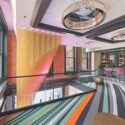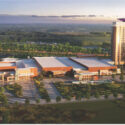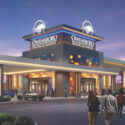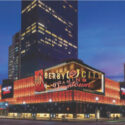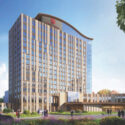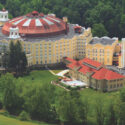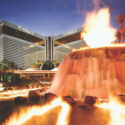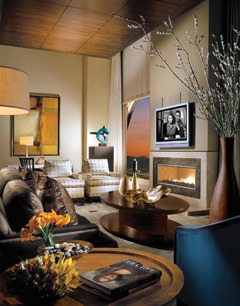
The hotel room has always been a place where gamblers could sleep in between the excitement of the casino floor and the showroom. No more. In today’s competitive market, guest rooms are as much of an attraction as the rest of the casino and hotel.
Whether it’s a compact, spare room or a themed suite with 1,600 square feet of space, hotel operators need to make the guest room experience comfortable and memorable. It takes more than fine linens and a 42-inch flat screen to impress today’s sophisticated guest. We will explore current trends in room accommodations that have proven to be successful in increasing guest satisfaction, especially those that create the desire to come back.
A lot of life goes on in a guest room. Jeff McIntyre, principal of premier hotel operator Gemstone Properties, likes to say that a guest room has four zones: the sleep zone, the entertainment zone, the work zone and the wet zone. When planning and evaluating rooms, McIntyre says that each zone needs to be carefully considered to allow each to stand on its own, while not conflicting with the concurrent use of other zones. For example, one guest may want to sleep while the other watches the game. A huge tub as a main centerpiece in a suite may be sexy, but not if the guest wants to use the room for a private business meeting.
As we go through the trends in each zone, it’s important to remember that they need to coexist. Unless specifically desired, as in the case of a themed suite, one zone should not dominate.
The Sleep Zone
Creating the standout room draws upon a palette of both high- and low-tech solutions. When considering the sleep zone, the most important factors will be the low-tech ones. The bed itself should be appropriately sized for the room. A California king in a compact room is not the right choice. Think of circulation around the bed as much as you think of the comfort of the bed itself. Select the right size for the room.
“Mattresses and linens are one of the strongest elements in forming guest impressions,” says Bill Langmade, president of Purchasing Management International. “More time is spent in contact with them than with any other portion of the room. A quality mattress is essential.”
There are now high-end installations where the choice of soft and firm pillows extends to the mattress itself, with adjustable support models. They need to be simple to operate, and long-term maintenance and dependability issues are still shaking out, but from a marketing perspective, these are a distinct bonus. Bed linens should, of course, be high thread-count, natural fibers, and the best you can initially afford to get payback in serviceability and satisfaction.
Think through bed placement. If you have spectacular nighttime views, the bed might want to face the windows. In a more traditional setting, the bed will want to overlook the entertainment zone. Maximize installations that allow control of room elements directly from the sleep zone. Being able to turn off the TV, turn down the lights and close the drapes without leaving the warm world under the covers will make a positive impression on your guests.
The Entertainment Zone
Entertainment is sparkle, showmanship, slick and, when done well, sublime. This is the best area to incorporate high-tech innovation. The communication wires into the room that used to support an analog telephone and “cable TV” are now the pipeline to the outside world. If used intelligently, it is also the pipeline to increased revenues and guest satisfaction.
A high-quality in-room information and entertainment system should offer all of the following: broadcast TV selections; a variety of music channels; premium and on-demand media options; access to front-desk functions like check-out, reservations, event ticketing and program schedules; room service options; in-house marketing and promotions; and the ever-necessary wake-up call.
On top of that not-so-basic platform, you should consider adding internet access, online entertainment gaming, tie-in to your wagering to the extent allowed, and easy accommodation and integration of end-user devices like iPods and iPads.
As you look into the state of the art of these systems, you will discover that vendors differentiate themselves primarily by the interfaces used, and system pricing changes accordingly. Low-cost, entry-level systems based on a TV screen and remote interface will run $500-$600 per key, exclusive of wiring, maintenance and shared revenue costs. Moving up to a keyboard interface will add about $200 per room. A full-blown dedicated touch-screen interface can easily add an additional $1,200 to the per-room cost.
You need to run a financial model to see if the payback is there based upon the services you can sell through an advanced interface, and then also consider if the more intangible “wow factor” is important to your market base. Some hotels’ entire marketing angle is based on high-tech features.
Entertainment does not live by electrons alone, though. Food for the body is as important as food for the brain. The options you’ll be able to offer for in-room dining will be largely dependent on the nature and capabilities of your general food-and-beverage operation. But as concerns the guest room itself, you are in control.
Once the food gets there, where does it go? Have you made a portion of the entertainment zone suitable for comfortable dining? In a small room, nested tables can do wonders. In a suite, the sky is the limit. The point is to plan it in. Don’t let dining be an afterthought with your guests balancing plates on their laps.
Having tricked out your room with the latest and greatest, give a thought to our tired business fellow who wants to sleep while his wife watches the Final Four. You want them to leave from their stay as happy as when they arrived. Arrange the room, and the elements in the room, so that two or more things can happen at once without conflicting. It’s not easy, and it will depend on the particulars of your physical constraints, but a good architect or interior designer can walk you through several tricks of their trade to get the job done.
The Work Zone
The line between work tools and play toys gets fuzzier every day. I’m writing this on my laptop, but tonight I’ll use the same laptop to grab a movie from Netflix, and I’ll patch into my plasma screen to watch it. My wife’s iPad runs spreadsheets on the flight north, and cool jazz on the flight south. It is both simpler and more complicated to accommodate work and productivity functions in the guest room than it used to be. I really don’t need a fax machine in my room, and I want to have to visit the business center only as a last resort when I’m at a resort for any reason.
What the room needs to provide is a convenient, comfortable and ergonomically correct workspace. And it needs to provide connections. Your guest will appreciate the capability to send a file to a remote printer and pick it up at the front desk on their way to a meeting much more than they will having to call the front desk because the printer in their room is hopelessly jammed. A fast connection to the internet will be a business person’s measure of quality, at least for that first hour each day catching up on emails.
The same infrastructure that services the information and entertainment needs will service the electronic needs of the business guest if adequate capacity is built into your network. You can do it with wired ethernet or adequate coverage of wireless access points. You need to make sure, though, that your pipe to the outside is big enough. A single T1 line is just not going to cut it anymore.
Once the connections are taken care of, the place to connect needs to be considered. A wireless network lets your guests work from anywhere in their room without having to worry about a cable reaching. And anywhere may be OK for a quick look at a file. But your business client will also have times where concentrated periods of work in their room are called for.
A comfortable chair and adequate desk space are essential. In smaller rooms, with built-in items along one wall, consider bowing out the built-in to make a deeper worktop. Provide outlets and task lighting. Try to keep this area free of the main traffic aisle in the room. And a stack table stowed under the worktop can do double duty as additional work area—and then a smart dining table for the great steak and a good wine as reward for a hard afternoon’s work.
And in case the Final Four has an afternoon game, you’d better be sure she can watch without disturbing him while he works.
The Wet Zone
Probably we should call the last area the “comfort zone,” because it is all about making your guest feel relaxed, comfortable and pampered.
Whether you go compact with a stall shower or opulent with a soaking tub complete with glass-walled city views, the most important characteristic is that they provide a satisfying experience. That means a small shower still has to be large enough to fully extend your arms while you wash. That means a single large sink cabinet allowing for generous counter space is probably better than crowding in a second sink at the expense of a good work area. That means an all-in-one bathroom still wants to offer some degree of internal privacy when a couple is in together preparing for a night out. “More stuff” isn’t necessarily the best stuff.
Lighting and linens are obvious measures of comfort. Guests really do appreciate thick, absorbent towels. Lighting needs to let him see well enough to shave while also dimming to a level where she can get her makeup just perfect for the club.
The practical details are what count in making this zone comfortable. A TV built into the mirror is nice, but a heated, fog-free mirror is nicer. A low-flow showerhead that leaves the feeling of shampoo in your hair is as bad as a high-pressure head that throws stinging darts of water at your back. Don’t trust the marketing hype. Find out where the fixtures you are considering are in use and then go try them yourself.
Fine-tuning is they key to the bathroom in a typical room. In a suite, you need that also, but then you want to add luxury. The mantra could very well be “a special place for everything.” Now we have room for multiple sinks, and we can differentiate them. A large basin for washing. A small one for shaving. A dressing mirror, a make-up mirror, a shaving mirror. A multi-head shower for a refreshing wash, that soaking tub with the killer view for winding down, and a couple-sized hot tub with music, soft lights and a champagne bucket for something else. Shelves belong within easy reach of each fixture—everything in its place and a place for everything.
Bathrooms are also a great marketing tie-in if you operate a spa on your property. Put out thick terry robes prominently displaying the spa logo. Select toiletries from items for sale at the spa, and present them in such a way that your guests are aware of it.
And don’t forget a heated floor. Talk about luxury.
The Green Zone
We used to say that guests are becoming more environmentally conscious. Now we say they are environmentally conscious. Particularly in a setting where it doesn’t directly impact their perceived cost to “do the right thing,” it is an important quality to them, and green features are something that conference planners actively seek out.
This green zone runs through the heart of our other four activity zones, and it is an area where unobtrusive technology is the answer. We’ll look at just a few areas that are both environmentally friendly and provide end-user comforts.
Environmental control systems save energy and can add features. Room lighting wired back to a central point allows for the use of small control panels that are programmed for different “scenes” or “moods.” Your guests can simply adjust the room lighting for their particular needs during the course of the day from a four- or five-button control.
It is the same technology you’ve been using in meeting rooms, but on a smaller scale.
And below the full levels, the settings all save energy. The same system can be tied into sensors that turn off all lights when the room is empty and turn them back on as soon as the door is opened.
The same type of occupied/unoccupied sensors can be used to conserve a little mechanical system energy and operating costs. In this instance, the temperature set point for the room can be moved up or down a few degrees when the room is empty so less energy is wasted providing comfort to an empty room. The typical HVAC system can bring the temperature back to the set level within a few minutes of return occupancy. And remote administration features allow even higher/lower set points when a room is not rented.
Heating and air conditioning systems in hotels historically have been largely recirculating systems. Indoor air quality is improved by using systems that instead introduce significant amounts of outside fresh air into the mix. Depending on the project location and the main mechanical systems, this can often allow a cost savings through the use of economizer cycles, waste heat recovery and heat exchange units. The key here is to tell your engineers early on that these are important features for them to consider.
In our wet zone, we already discussed low-volume shower heads. A well-designed one will use much less water without diminishing the end-user experience. Low-volume toilets have had a mixed record, but the newer dual-flush models are seeing wider guest acceptance.
The key to successful use of green technologies is to make them as transparent to the guest as possible, and to focus on those that have value-added features in addition to their being environmentally friendly. Everyone wants to do their part, but always keep in mind that most of your guests appreciate comfort more than sacrifice.
The End Zone
We hope we’ve given you a number of tools to analyze your existing and proposed facilities, as well as a few good specific ideas to investigate further. But before closing, one more item: thinking through how to put all these pieces together.
In a large suite, it is relatively easy to make each zone really great, because of the space available. As the room size gets smaller, this becomes more and more of a challenge. With smaller rooms, you need to have an overall marketing strategy to show you the best path. This is done successfully in two different ways: hotels that offer a variety of room types to please a variety of guests, and hotels that come up with a marketing hook to focus on a particular guest experience. Think of an “aloft” type of hotel guest room as the latter. Compact, high-tech, efficient. That vibe and aesthetic takes the pressure off, making each individual zone great. The selling point is the small-footprint ensemble.
The other successful model is to offer variety. We’ll see a stacked bay of rooms with killer bathrooms that are in fact the center of the room experience. Next to it will be a stacked bay of suites that have a larger work area and a wet bar for entertaining. The business crowd gobbles these up. Next along is a two-room suite that is laid out for families. The idea here is to do a number of things well, and to use different room configurations to accomplish it. The extreme version of this model will even go as far as theming each large suite, so the luxury guests can find a suite to suit each time they come to visit.
The weakest model we see, and the one to avoid, is the hotel that was not planned. The hotel with no narrative—a hotel that is not marketed to a defined group of guests. Do that and you end up being nothing to anybody rather than something for everyone.
The state of the art is a mix of high-tech features and old-fashioned comforts and service. Always check that you use technology in the service of comfort. A thermostat with a green “up” arrow and a red “down” arrow and nothing else is going to win you more return guests than one that has a flip-open cover with a page of instructions. A great place to wash your face is more valuable to your guest than three so-so places. The ability to use different parts of the guest room for different functions during the course of the day and not have them intrude on each other is key.
As you evaluate options and make decisions, put yourself in your guest’s place. Imagine walking into your room, putting away your clothes, washing up, and having a snack. A design and amenities that satisfy you will likely do the same for your guests.
On the way home from their stay, you want him to think to himself how well he slept, and her to remember that great quarter-final game. You planned carefully to make it happen, but all they need to know is that they loved their stay. Something about it was just right. They’ll be back.



